I just a little bit eddit.Namely, removed the value change events, added the ability to change light and dark colors, fixed the display of the contents of the container. Also, based on this class, another class was created to add inner shadows.It work with PySide6.
Important! Inner shadows are drawing after the content is drawed, so don't make the shadows too big as this can obscure the content. This is done in order to preserve the ability to change the background color.
class OutsideNeumorphismEffect(QtWidgets.QGraphicsEffect):
_cornerShift = (
QtCore.Qt.TopLeftCorner, QtCore.Qt.TopLeftCorner, QtCore.Qt.BottomRightCorner, QtCore.Qt.BottomLeftCorner)
def __init__(self, distance: int = 4, lightColor: QtGui.QColor = QtGui.QColor("#FFFFFF"),
darkColor: QtGui.QColor = QtGui.QColor("#7d7d7d"), clipRadius: int = 4,
origin=QtCore.Qt.TopLeftCorner):
super().__init__()
self._leftGradient = QtGui.QLinearGradient(1, 0, 0, 0)
self._leftGradient.setCoordinateMode(QtGui.QGradient.ObjectBoundingMode)
self._topGradient = QtGui.QLinearGradient(0, 1, 0, 0)
self._topGradient.setCoordinateMode(QtGui.QGradient.ObjectBoundingMode)
self._rightGradient = QtGui.QLinearGradient(0, 0, 1, 0)
self._rightGradient.setCoordinateMode(QtGui.QGradient.ObjectBoundingMode)
self._bottomGradient = QtGui.QLinearGradient(0, 0, 0, 1)
self._bottomGradient.setCoordinateMode(QtGui.QGradient.ObjectBoundingMode)
self._radial = QtGui.QRadialGradient(.5, .5, .5)
self._radial.setCoordinateMode(QtGui.QGradient.ObjectBoundingMode)
self._conical = QtGui.QConicalGradient(.5, .5, 0)
self._conical.setCoordinateMode(QtGui.QGradient.ObjectBoundingMode)
self._origin = origin
distance = max(0, distance)
self._clipRadius = min(distance, max(0, clipRadius))
self._setColors(lightColor, darkColor)
self._setDistance(distance)
def setColors(self, color1, color2):
if isinstance(color1, QtCore.Qt.GlobalColor) and isinstance(color2, QtCore.Qt.GlobalColor):
color1 = QtGui.QColor(color1)
color2 = QtGui.QColor(color2)
self._setColors(color1, color2)
self._setDistance(self._distance)
self.update()
def _setColors(self, color1, color2):
self._baseStart = color1
self._baseStop = QtGui.QColor(color1)
self._baseStop.setAlpha(0)
self._shadowStart = color2
self._shadowStop = QtGui.QColor(color2)
self._shadowStop.setAlpha(0)
self.lightSideStops = [(0, self._baseStart), (1, self._baseStop)]
self.shadowSideStops = [(0, self._shadowStart), (1, self._shadowStop)]
self.cornerStops = [(0, self._shadowStart), (.25, self._shadowStop),
(.75, self._shadowStop), (1, self._shadowStart)]
self._setOrigin(self._origin)
def distance(self):
return self._distance
def setDistance(self, distance):
if distance == self._distance:
return
self._setDistance(distance)
self.updateBoundingRect()
def _getCornerPixmap(self, rect, grad1, grad2=None):
pm = QtGui.QPixmap(self._distance + self._clipRadius, self._distance + self._clipRadius)
pm.fill(QtCore.Qt.transparent)
qp = QtGui.QPainter(pm)
if self._clipRadius > 1:
path = QtGui.QPainterPath()
path.addRect(rect)
size = self._clipRadius * 2 - 1
mask = QtCore.QRectF(0, 0, size, size)
mask.moveCenter(rect.center())
path.addEllipse(mask)
qp.setClipPath(path)
qp.fillRect(rect, grad1)
if grad2:
qp.setCompositionMode(qp.CompositionMode_SourceAtop)
qp.fillRect(rect, grad2)
qp.end()
return pm
def _setDistance(self, distance):
distance = max(1, distance)
self._distance = distance
if self._clipRadius > distance:
self._clipRadius = distance
distance += self._clipRadius
r = QtCore.QRectF(0, 0, distance * 2, distance * 2)
lightSideStops = self.lightSideStops[:]
shadowSideStops = self.shadowSideStops[:]
if self._clipRadius:
gradStart = self._clipRadius / (self._distance + self._clipRadius)
lightSideStops[0] = (gradStart, lightSideStops[0][1])
shadowSideStops[0] = (gradStart, shadowSideStops[0][1])
# create the 4 corners as if the light source was top-left
self._radial.setStops(lightSideStops)
topLeft = self._getCornerPixmap(r, self._radial)
self._conical.setAngle(359.9)
self._conical.setStops(self.cornerStops)
topRight = self._getCornerPixmap(r.translated(-distance, 0), self._radial, self._conical)
self._conical.setAngle(270)
self._conical.setStops(self.cornerStops)
bottomLeft = self._getCornerPixmap(r.translated(0, -distance), self._radial, self._conical)
self._radial.setStops(shadowSideStops)
bottomRight = self._getCornerPixmap(r.translated(-distance, -distance), self._radial)
# rotate the images according to the actual light source
images = topLeft, topRight, bottomRight, bottomLeft
shift = self._cornerShift.index(self._origin)
if shift:
transform = QtGui.QTransform().rotate(shift * 90)
for img in images:
img.swap(img.transformed(transform, QtCore.Qt.SmoothTransformation))
# and reorder them if required
self.topLeft, self.topRight, self.bottomRight, self.bottomLeft = images[-shift:] + images[:-shift]
def origin(self):
return self._origin
def setOrigin(self, origin):
origin = QtCore.Qt.Corner(origin)
if origin == self._origin:
return
self._setOrigin(origin)
self._setDistance(self._distance)
self.update()
def _setOrigin(self, origin):
self._origin = origin
gradients = self._leftGradient, self._topGradient, self._rightGradient, self._bottomGradient
stops = self.lightSideStops, self.lightSideStops, self.shadowSideStops, self.shadowSideStops
# assign color stops to gradients based on the light source position
shift = self._cornerShift.index(self._origin)
for grad, stops in zip(gradients, stops[-shift:] + stops[:-shift]):
grad.setStops(stops)
def clipRadius(self):
return self._clipRadius
def setClipRadius(self, radius):
if radius == self._clipRadius:
return
self._setClipRadius(radius)
self.update()
def _setClipRadius(self, radius):
radius = min(self._distance, max(0, int(radius)))
self._clipRadius = radius
self._setDistance(self._distance)
def boundingRectFor(self, rect):
d = self._distance
return rect.adjusted(-d, -d, d, d)
def draw(self, qp):
restoreTransform = qp.worldTransform()
qp.setPen(QtCore.Qt.NoPen)
x, y, width, height = self.sourceBoundingRect(QtCore.Qt.DeviceCoordinates).getRect()
right = x + width
bottom = y + height
clip = self._clipRadius
doubleClip = clip * 2
if self._clipRadius:
path = QtGui.QPainterPath()
source = self.sourcePixmap(QtCore.Qt.DeviceCoordinates)
sourceBoundingRect = self.sourceBoundingRect(QtCore.Qt.DeviceCoordinates)
qp.save()
qp.setTransform(QtGui.QTransform())
path.addRoundedRect(sourceBoundingRect.x(), sourceBoundingRect.y(), sourceBoundingRect.width(),
sourceBoundingRect.height(), self._clipRadius, self._clipRadius)
qp.setClipPath(path)
qp.drawPixmap(sourceBoundingRect.x() - self._distance, sourceBoundingRect.y() - self._distance, source)
qp.restore()
else:
path = QtGui.QPainterPath()
source = self.sourcePixmap(QtCore.Qt.DeviceCoordinates)
sourceBoundingRect = self.sourceBoundingRect(QtCore.Qt.DeviceCoordinates)
qp.save()
qp.setTransform(QtGui.QTransform())
path.addRect(sourceBoundingRect.x(), sourceBoundingRect.y(), sourceBoundingRect.width(),
sourceBoundingRect.height())
qp.setClipPath(path)
qp.drawPixmap(sourceBoundingRect.x() - self._distance, sourceBoundingRect.y() - self._distance, source)
qp.restore()
qp.setWorldTransform(QtGui.QTransform())
leftRect = QtCore.QRectF(x - self._distance, y + clip, self._distance, height - doubleClip)
qp.setBrush(self._leftGradient)
qp.drawRect(leftRect)
topRect = QtCore.QRectF(x + clip, y - self._distance, width - doubleClip, self._distance)
qp.setBrush(self._topGradient)
qp.drawRect(topRect)
rightRect = QtCore.QRectF(right, y + clip, self._distance, height - doubleClip)
qp.setBrush(self._rightGradient)
qp.drawRect(rightRect)
bottomRect = QtCore.QRectF(x + clip, bottom, width - doubleClip, self._distance)
qp.setBrush(self._bottomGradient)
qp.drawRect(bottomRect)
qp.drawPixmap(x - self._distance, y - self._distance, self.topLeft)
qp.drawPixmap(right - clip, y - self._distance, self.topRight)
qp.drawPixmap(right - clip, bottom - clip, self.bottomRight)
qp.drawPixmap(x - self._distance, bottom - clip, self.bottomLeft)
qp.setWorldTransform(restoreTransform)
class InsideNeumorphismEffect(QtWidgets.QGraphicsEffect):
_cornerShift = (QtCore.Qt.TopLeftCorner, QtCore.Qt.TopRightCorner,
QtCore.Qt.BottomRightCorner, QtCore.Qt.BottomLeftCorner)
def __init__(self, distance: int = 4, lightColor: QtGui.QColor = QtGui.QColor("#FFFFFF"),
darkColor: QtGui.QColor = QtGui.QColor("#7d7d7d"), clipRadius: int = 4,
origin=QtCore.Qt.BottomRightCorner):
super().__init__()
self._leftGradient = QtGui.QLinearGradient(0, 0, 1, 0)
self._leftGradient.setCoordinateMode(QtGui.QGradient.ObjectBoundingMode)
self._topGradient = QtGui.QLinearGradient(0, 0, 0, 1)
self._topGradient.setCoordinateMode(QtGui.QGradient.ObjectBoundingMode)
self._rightGradient = QtGui.QLinearGradient(1, 0, 0, 0)
self._rightGradient.setCoordinateMode(QtGui.QGradient.ObjectBoundingMode)
self._bottomGradient = QtGui.QLinearGradient(0, 1, 0, 0)
self._bottomGradient.setCoordinateMode(QtGui.QGradient.ObjectBoundingMode)
self._radial = QtGui.QRadialGradient(.5, .5, .5)
self._radial.setCoordinateMode(QtGui.QGradient.ObjectBoundingMode)
self._conical = QtGui.QConicalGradient(.5, .5, 0)
self._conical.setCoordinateMode(QtGui.QGradient.ObjectBoundingMode)
self._origin = origin
distance = max(0, distance)
self._clipRadius = min(distance, max(0, clipRadius))
self._setColors(lightColor, darkColor)
self._setDistance(distance)
def setColors(self, color1, color2):
if isinstance(color1, QtCore.Qt.GlobalColor) and isinstance(color2, QtCore.Qt.GlobalColor):
color1 = QtGui.QColor(color1)
color2 = QtGui.QColor(color2)
self._setColors(color1, color2)
self._setDistance(self._distance)
self.update()
def _setColors(self, color1, color2):
self._baseStart = color1
self._baseStop = QtGui.QColor(color1)
self._baseStop.setAlpha(0)
self._shadowStart = color2
self._shadowStop = QtGui.QColor(color2)
self._shadowStop.setAlpha(0)
self.lightSideStops = [(0, self._baseStart), (1, self._baseStop)]
self.shadowSideStops = [(0, self._shadowStart), (1, self._shadowStop)]
self.cornerStops = [(0, self._shadowStart), (.25, self._shadowStop),
(.75, self._shadowStop), (1, self._shadowStart)]
self._setOrigin(self._origin)
def distance(self):
return self._distance
def setDistance(self, distance):
if distance == self._distance:
return
self._setDistance(distance)
self.updateBoundingRect()
def _getCornerPixmap(self, rect, grad1, grad2=None):
pm = QtGui.QPixmap(self._distance + self._clipRadius, self._distance + self._clipRadius)
pm.fill(QtCore.Qt.transparent)
qp = QtGui.QPainter(pm)
if self._clipRadius > 1:
path = QtGui.QPainterPath()
size = self._clipRadius * 2 - 1
el = QtCore.QRectF(0, 0, size, size)
path.addEllipse(rect)
qp.setClipPath(path)
qp.fillRect(rect, grad1)
if grad2:
qp.setCompositionMode(qp.CompositionMode_SourceAtop)
qp.fillRect(rect, grad2)
qp.end()
return pm
def _setDistance(self, distance):
distance = max(1, distance)
self._distance = distance
if self._clipRadius > distance:
self._clipRadius = distance
distance += self._clipRadius
r = QtCore.QRectF(0, 0, distance * 2, distance * 2)
lightSideStops = self.lightSideStops[:]
shadowSideStops = self.shadowSideStops[:]
if self._clipRadius:
gradStart = self._clipRadius / (self._distance + self._clipRadius)
lightSideStops[0] = (1, lightSideStops[0][1])
lightSideStops[1] = (gradStart, lightSideStops[1][1])
shadowSideStops[1] = (gradStart, shadowSideStops[1][1])
shadowSideStops[0] = (1, shadowSideStops[0][1])
else:
lightSideStops[0] = (1, lightSideStops[0][1])
lightSideStops[1] = (0, lightSideStops[1][1])
shadowSideStops[1] = (0, shadowSideStops[1][1])
shadowSideStops[0] = (1, shadowSideStops[0][1])
# create the 4 corners as if the light source was top-left
self._radial.setStops(lightSideStops)
topLeft = self._getCornerPixmap(r, self._radial)
self._conical.setAngle(359.9)
self._conical.setStops(self.cornerStops)
topRight = self._getCornerPixmap(r.translated(-distance, 0), self._radial, self._conical)
self._conical.setAngle(270)
self._conical.setStops(self.cornerStops)
bottomLeft = self._getCornerPixmap(r.translated(0, -distance), self._radial, self._conical)
self._radial.setStops(shadowSideStops)
bottomRight = self._getCornerPixmap(r.translated(-distance, -distance), self._radial)
# rotate the images according to the actual light source
images = topLeft, topRight, bottomRight, bottomLeft
shift = self._cornerShift.index(self._origin)
if shift:
transform = QtGui.QTransform().rotate(shift * 90)
for img in images:
img.swap(img.transformed(transform, QtCore.Qt.SmoothTransformation))
# and reorder them if required
self.topLeft, self.topRight, self.bottomRight, self.bottomLeft = images[-shift:] + images[:-shift]
def origin(self):
return self._origin
def setOrigin(self, origin):
origin = QtCore.Qt.Corner(origin)
if origin == self._origin:
return
self._setOrigin(origin)
self._setDistance(self._distance)
self.update()
def _setOrigin(self, origin):
self._origin = origin
gradients = self._leftGradient, self._topGradient, self._rightGradient, self._bottomGradient
stops = self.lightSideStops, self.lightSideStops, self.shadowSideStops, self.shadowSideStops
# assign color stops to gradients based on the light source position
shift = self._cornerShift.index(self._origin)
for grad, stops in zip(gradients, stops[-shift:] + stops[:-shift]):
grad.setStops(stops)
def clipRadius(self):
return self._clipRadius
def setClipRadius(self, radius):
if radius == self._clipRadius:
return
self._setClipRadius(radius)
self.update()
def _setClipRadius(self, radius):
radius = min(self._distance, max(0, int(radius)))
self._clipRadius = radius
self._setDistance(self._distance)
def boundingRectFor(self, rect):
d = self._distance
return rect.adjusted(-d, -d, d, d)
def draw(self, qp):
restoreTransform = qp.worldTransform()
qp.setPen(QtCore.Qt.NoPen)
x, y, width, height = self.sourceBoundingRect(QtCore.Qt.DeviceCoordinates).getRect()
right = x + width
bottom = y + height
clip = self._clipRadius
doubleClip = clip * 2
if self._clipRadius:
path = QtGui.QPainterPath()
source = self.sourcePixmap(QtCore.Qt.DeviceCoordinates)
sourceBoundingRect = self.sourceBoundingRect(QtCore.Qt.DeviceCoordinates)
qp.save()
qp.setTransform(QtGui.QTransform())
path.addRoundedRect(sourceBoundingRect, self._clipRadius, self._clipRadius)
qp.setClipPath(path)
qp.drawPixmap(sourceBoundingRect.x() - self._distance, sourceBoundingRect.y() - self._distance, source)
qp.restore()
else:
path = QtGui.QPainterPath()
source = self.sourcePixmap(QtCore.Qt.DeviceCoordinates)
sourceBoundingRect = self.sourceBoundingRect(QtCore.Qt.DeviceCoordinates)
qp.save()
qp.setTransform(QtGui.QTransform())
path.addRect(sourceBoundingRect.x(), sourceBoundingRect.y(), sourceBoundingRect.width(),
sourceBoundingRect.height())
qp.setClipPath(path)
qp.drawPixmap(sourceBoundingRect.x() - self._distance, sourceBoundingRect.y() - self._distance, source)
qp.restore()
qp.setWorldTransform(QtGui.QTransform())
leftRect = QtCore.QRectF(x, y + clip + self._distance, self._distance,
height - doubleClip - self._distance * 2)
qp.setBrush(self._leftGradient)
qp.drawRect(leftRect)
topRect = QtCore.QRectF(x + clip + self._distance, y, width - doubleClip - self._distance * 2,
self._distance)
qp.setBrush(self._topGradient)
qp.drawRect(topRect)
rightRect = QtCore.QRectF(right - self._distance, y + clip + self._distance, self._distance,
height - doubleClip - self._distance * 2)
qp.setBrush(self._rightGradient)
qp.drawRect(rightRect)
bottomRect = QtCore.QRectF(x + clip + self._distance, bottom - self._distance,
width - doubleClip - self._distance * 2, self._distance)
qp.setBrush(self._bottomGradient)
qp.drawRect(bottomRect)
qp.drawPixmap(x, y, self.topLeft)
qp.drawPixmap(right - clip - self._distance, y, self.topRight)
qp.drawPixmap(right - clip - self._distance, bottom - clip - self._distance, self.bottomRight)
qp.drawPixmap(x, bottom - clip - self._distance, self.bottomLeft)
qp.setWorldTransform(restoreTransform)




